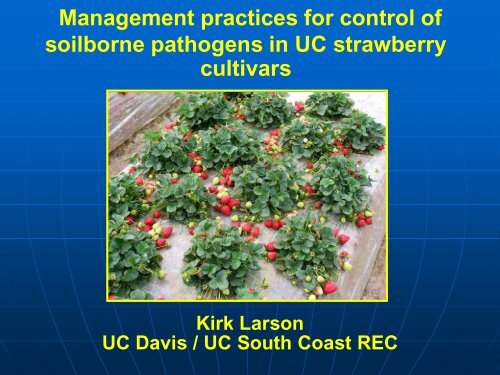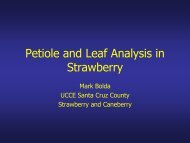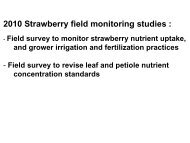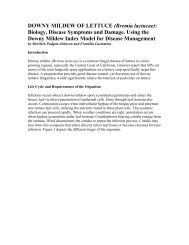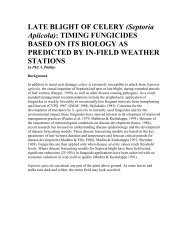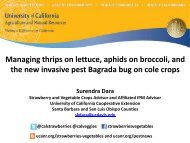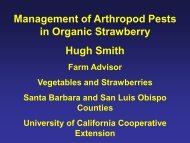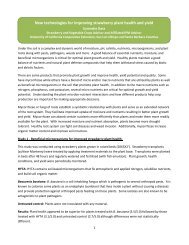Soilborne Pathogen Control in UC Cultivars, Kirk Larson
Soilborne Pathogen Control in UC Cultivars, Kirk Larson
Soilborne Pathogen Control in UC Cultivars, Kirk Larson
Create successful ePaper yourself
Turn your PDF publications into a flip-book with our unique Google optimized e-Paper software.
Management practices for control of<br />
soilborne pathogens <strong>in</strong> <strong>UC</strong> strawberry<br />
cultivars<br />
<strong>Kirk</strong> <strong>Larson</strong><br />
<strong>UC</strong> Davis / <strong>UC</strong> South Coast REC
High-<br />
Elevation<br />
Nurseries<br />
Low-Elevation<br />
Nurseries<br />
California strawberry<br />
nursery and fruit<br />
production regions<br />
Watsonville/<br />
Sal<strong>in</strong>as<br />
Central<br />
Valley<br />
Santa Maria<br />
Oxnard<br />
Orange County<br />
San Diego<br />
Coachella<br />
Valley
Major strawberry soilborne pathogens<br />
Phytophthora cactorum root & crown rot<br />
Verticillium dahliae<br />
Macrophom<strong>in</strong>a phaseol<strong>in</strong>a<br />
Fusarium oxysporum<br />
Colletotrichum acutatum* root & crown rot<br />
Botrytis* petiole, crown and root rot<br />
Viruses and phytoplasms*<br />
* Technically not soilborne pathogens
Superior plant quality starts <strong>in</strong> the nursery…<br />
- Pest- and disease-free plants<br />
(meristem culture, soil fumigation, BMPs)<br />
- Location, soil type, dig date, handl<strong>in</strong>g<br />
- Physiological condition<strong>in</strong>g (chill, CHO+N levels)<br />
- Plant size / development<br />
…but does not end there<br />
- Plant selection, postharvest handl<strong>in</strong>g, transport<br />
- Establishment conditions, methods<br />
- Fruit<strong>in</strong>g field BMPs
Heat treatment<br />
Suppresses viruses and other pathogens
Disease-free<br />
meristem<br />
plant<br />
Photo courtesy C. Ga<strong>in</strong>es
Meristem Propagation<br />
- Elim<strong>in</strong>ates plant pathogens<br />
- Enhances plant vigor<br />
- Plants derived from meristem culture will<br />
rema<strong>in</strong> pathogen-free if kept isolated<br />
from sources of contam<strong>in</strong>ation<br />
(attention to sanitation, BMPs)
Screenhouse<br />
propagation<br />
Each meristem<br />
plant produces<br />
100-200 daughter<br />
plants
Foundation Block - Isolation<br />
Photo courtesy C. Ga<strong>in</strong>es
Low elevation <strong>in</strong>crease nursery
Nursery development<br />
September 1<br />
Low elevation nursery<br />
planted late May - June<br />
(
California nurseries ship plants worldwide
Generational <strong>in</strong>crease <strong>in</strong> plant numbers<br />
from one meristem<br />
1 meristem plant 100 Screenhouse daughters<br />
100 Foundation plts X 100 10,000 daughters<br />
10,000 LE <strong>in</strong>crease plts X 100 1m daughters<br />
1m HE <strong>in</strong>crease plts X 30<br />
30m daughters<br />
1 meristem plant can easily generate<br />
30,000,000 plants <strong>in</strong> four years<br />
<strong>Pathogen</strong>s or off-types can become explosive!
Breed<strong>in</strong>g for disease tolerance/resistance<br />
Helpful & desireable, but not a complete solution:<br />
- high <strong>in</strong>ocula levels can overcome resistance<br />
- resistance to all major pathogens is statistically<br />
impossible<br />
A comb<strong>in</strong>ation of horticultural management<br />
and resistance breed<strong>in</strong>g is likely to be most<br />
effective way to m<strong>in</strong>imize harmful<br />
effects of soilborne pathogens
Disease resistance scores for <strong>UC</strong><br />
short-day cultivars, 2004-07<br />
Phytophthora Verticillium C. acutatum<br />
resistance resistance resistance<br />
Genotype (5 = best) (5 = best) (5 = best)<br />
Camarosa 3.6 2.5 2.6<br />
Cam<strong>in</strong>o R 4.4 4.2 3.1<br />
Ventana 2.5 3.0 3.0<br />
Palomar 2.4 3.3 3.2<br />
Resistance score: 5 = most resistant
Disease resistance scores<br />
for <strong>UC</strong> day neutral cultivars, 2004-07<br />
Phytophthora Verticillium C. acutatum<br />
resistance resistance resistance<br />
Genotype (5 = best) (5 = best) (5 = best)<br />
Albion 4.3 3.8 3.4<br />
Monterey 3.2 3.4 2.4<br />
S. Andreas 3.8 3.8 2.9<br />
Portola 4.4 3.3 2.7
Phytophthora cactorum <strong>in</strong> HE nursery<br />
Pythium and Phytophthora are <strong>in</strong><br />
same general class of fungi
Phytophthora cactorum <strong>in</strong> fruit<strong>in</strong>g field
Phytophthora/Pythium control strategies<br />
- Choose well-dra<strong>in</strong>ed soils and sites – avoid<br />
heavy soils and low-ly<strong>in</strong>g areas<br />
- Deep rip 3-4 ways<br />
- Pre-plant soil fumigation us<strong>in</strong>g the most<br />
effective compounds available<br />
- Pre-plant dip with Aliette, Phosgard, etc.<br />
- Regular applications of Phosgard, Ridomil,<br />
Aliette<br />
- Irrigate appropriately
Phosphorous acid materials<br />
Phosphorous acid (H 3 PO 3 , Phosguard, etc.)<br />
dissociates <strong>in</strong>to phosphite ion (HPO 3<br />
-2<br />
)<br />
Phosphite readily taken up/translocated <strong>in</strong> plant<br />
but is not converted to phosphate (nutrient)<br />
Phosphite contributes little or noth<strong>in</strong>g to P<br />
nutrition of plant<br />
Phosphorous acid fungicides are effective<br />
aga<strong>in</strong>st water molds (Oomycetes) such as<br />
Phytophthora and Pythium<br />
Are stable <strong>in</strong> plant, apply <strong>in</strong>frequently (~1x/month)
Performance of SD cultivars with or without<br />
Phosguard treatments*, Irv<strong>in</strong>e 2006-07<br />
Phos- 12# C/A to Size App Firm<br />
Item gard 3/1 4/1 6/1 (g) (1-5) (1-5)<br />
Camarosa Yes 1355 2601 8492 30.8 2.6 3.5<br />
No 999 2250 8478 30.6 2.6 3.4<br />
Palomar Yes 1562 3258 8001 30.1 3.8 3.8<br />
No 1409 2876 7511 30.4 3.8 3.8<br />
Ventana Yes 1031 2965 8532 30.7 3.4 3.6<br />
No 990 2880 7839 29.8 3.4 3.5<br />
* Phosguard applied as a pre-plant dip, then at monthly<br />
<strong>in</strong>tervals through the drip irrigation system
Verticillium <strong>in</strong> HE transplants
Fumigated and non-fumigated<br />
runner nursery plots<br />
No Verticillium wilt<br />
Verticillium wilt
InL<strong>in</strong>e<br />
fumigated *<br />
HE nursery<br />
plot<br />
Note<br />
Verticillium<br />
symptoms<br />
*445#/a of 2:1 (wt:wt) Telone:chloropicr<strong>in</strong>
Verticillium control strategies<br />
Avoid crop rotations that <strong>in</strong>clude tomato, potato,<br />
alfalfa, cotton, olive<br />
Use preplant soil fumigation with highest<br />
possible rates of the most-effective fumigants<br />
In strawberry nurseries, apply fumigants <strong>in</strong> fall<br />
rather than <strong>in</strong> spr<strong>in</strong>g
Non-treated Vapam Chloropicr<strong>in</strong><br />
Methyl bromide alternatives
Nursery soil fumigation<br />
Transplants from<br />
MBPic-fumigated<br />
nursery<br />
Transplants from<br />
non-fumigated<br />
nursery with no<br />
detectable<br />
pathogens
Macrophom<strong>in</strong>a<br />
phaseol<strong>in</strong>a
M. phaseol<strong>in</strong>a<br />
Wide host range<br />
Prefers warm, dry soil<br />
Variable cultivar susceptibility<br />
2009: Genetic screen (<strong>Larson</strong>, Gordon, Koike, Shaw)<br />
Flat fume with MBPic to elim<strong>in</strong>ate all pathogens<br />
Establish plants of Albion, <strong>in</strong>oculate with Mp<br />
Incorporate <strong>in</strong>oculated plants <strong>in</strong>to soil<br />
Establish 50+ HE cultivars and selections<br />
Rate plant vigor and survival<br />
Also <strong>in</strong> 2009: Implement fungicide efficacy trials
Establish Albion<br />
plants <strong>in</strong> fumigated<br />
soil<br />
Inoculate with Mp
Inoculation,<br />
<strong>in</strong>fection<br />
and<br />
<strong>in</strong>corporation
Establish replicated<br />
plots <strong>in</strong> clean<br />
and <strong>in</strong>fested soil<br />
Infested plots<br />
<strong>Control</strong> plots
Strategies for controll<strong>in</strong>g Macrophom<strong>in</strong>a<br />
Choose colder sites (?)<br />
Avoid soil water-stress<br />
Anecdotal evidence suggests differences <strong>in</strong><br />
varietal susceptibility<br />
Tops<strong>in</strong> applications may help suppress Mp
Fusarium oxysporum<br />
Genetic screen similar to Macrophom<strong>in</strong>a screen<br />
is be<strong>in</strong>g developed by D. Shaw and T. Gordon<br />
at <strong>UC</strong> Davis
Can cause<br />
root and<br />
crown <strong>in</strong>fection<br />
C. acutatum<br />
Not a true soil pathogen
Transplants<br />
<strong>in</strong>fected with<br />
C. acutatum
Colletotrichum acutatum<br />
Fruit & flower <strong>in</strong>fection <strong>in</strong> fruit<strong>in</strong>g field
C. acutatum control strategies<br />
Pre-plant hot-water dip <strong>in</strong> low-elevation nurseries<br />
Pre-plant fungicide dip<br />
(Abound, Rovral, Tops<strong>in</strong>, etc.)<br />
Apply foliar fungicides on a rout<strong>in</strong>e basis<br />
Move workers from clean to <strong>in</strong>fected fields
Preplant fungicide dip for control of<br />
C. acutatum and other diseases <strong>in</strong><br />
nurseries and fruit<strong>in</strong>g fields<br />
<strong>Control</strong><br />
Wash<br />
Wash +<br />
Quadris dip<br />
Reduces pathogen levels, re-hydrates plants
C. acutatum genetic screen
C. acutatum genetic screen<br />
Cultivar<br />
<strong>in</strong>fo<br />
Sweet Charlie<br />
Parent<br />
selection<br />
‘05 selection<br />
‘05 selection
Drip-irrigated runner nurseries<br />
Nursery drip irrigation used at SCFS s<strong>in</strong>ce 1998<br />
Reduces <strong>in</strong>cidence of certa<strong>in</strong> pathogens<br />
Periodic spr<strong>in</strong>kler irrigation to manage soil sal<strong>in</strong>ity
Phytoplasms<br />
Leafhoppervectored<br />
Multiplier disease
Viruses
Vectors: aphids, whitefly,<br />
leafhoppers<br />
Virus<br />
complexes
<strong>Control</strong> strategies for viruses and<br />
phytoplasms<br />
Use systemic and contact <strong>in</strong>secticides to control<br />
aphids, leafhoppers, whitefly:<br />
Admire, Esteem, Disyston, Malathion+Danitol<br />
Elim<strong>in</strong>ate weeds that can be host plants<br />
Isolation from other strawberry plant<strong>in</strong>gs
Botrytis fruit rot<br />
Also: Botrytis petiole, crown and root rot
New <strong>UC</strong> strawberry<br />
(Pomology) website:<br />
http://www.plantsciences.ucdavis.edu/ucstrawberry
THANK YOU!


